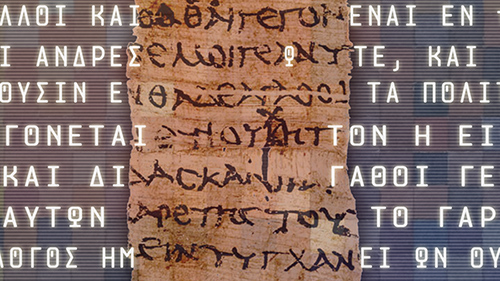- PROGRAMS
- Computational Palaeography and Papyrology
Computational Palaeography and Papyrology
Compare
Apply
Short Overview
The aim of the programme is to introduce students to the study of primary sources of the ancient world and the relevant digital tools used in contemporary research, as well as to the methods and academic approaches of Digital Humanities. All teaching staff collaborate with the UNESCO Chair in Digital Methods for the Humanities and Social Sciences and teach in the Postgraduate Programme in Digital Methods for the Humanities at the AUEB.
Learning Goals
At the end of the programme students will
- be able to understand the editions of classical texts preserved in scrolls and manuscripts and apply their techniques,
- be able to understand machine learning for HTR system training,
- be able to understand basic principles of programming,
- have become familiar with the Python programming language,
- have gotten acquainted with natural language processing by computational means,
- have practiced with regular expressions,
- have become acquainted with large language models as programming assistants,
- be able to use the Transkribus platform to produce transcriptions and train automatic transcription models for manuscripts
- be able to decode and encode text versions and metadata in XML
Program Value
Students will learn methods beyond the narrow scope of the humanities and will become familiar with new technologies in the study of the ancient world. The development of the relevant digital skills is encouraged, regardless of their academic background, which are useful assets for the students’ professional careers. It is an introduction to the field of Digital Humanities and the professional opportunities it offers.
Learning Method Description
The trainees participate through Live Streaming from the place of their choice. This method provides the following advantages:
- Education without geographical restrictions.
- The possibility to ask the instructor questions.
- Online availability of the educational material of the program (the entire educational material is offered free of charge).
Teaching Language
Greek
Application deadline: 28/02/2026
Program start: -
Program completion: -
Scientific area
Way to follow
ECTS units: 5
Hours of live training: 26
Includes training hours with classroom, laboratory, or remote (via live streaming) instruction along with any breaks.
Includes training hours with classroom, laboratory, or remote (via live streaming) instruction along with any breaks.
Additional hours of employment: 124
Additional hours of work are included (indicative) and may include individual study, writing assignments, participation in field visits, participation in exams, etc.
Additional hours of work are included (indicative) and may include individual study, writing assignments, participation in field visits, participation in exams, etc.
Total hours: 150
The total hours include hours of synchronous and asynchronous training, as well as additional hours of employment.
The total hours include hours of synchronous and asynchronous training, as well as additional hours of employment.
Weeks of training: 13
Weeks in which activities of any kind are planned are included.
Weeks in which activities of any kind are planned are included.
Maximum number of absences: 2
Vocational Education and Training Certificate
Trainees who successfully complete the program are granted a Vocational Education and Training Certificate of the Center for Education and Lifelong Learning of the Athens University of Economics and Business, which is accompanied by a Supplement to the Certificate, detailing the subject of the program, the thematic units attended by the trainee , as well as the training methodology followed.
Target Audience
Primarily, the program is aimed at undergraduate students and holders of degrees in the humanities.
Scientific Coordinator
Program Tutors
Cost
LIVE STREAMING: 200€
Trainees are informed of the installment amounts and related deadlines via email upon their acceptance into the program.
CONTACT
45, Kefallinias Str., 11257, Athens
-
dummy secretariat@diaviou.aueb.gr
-
dummy+30 210 8203 913
For the in Class programs:
-
dummydiazosis@diaviou.aueb.gr
-
dummy+30 210 8203 916, 912, 914
For the eLearning Programs:
-
dummyelearning@diaviou.aueb.gr
-
dummy+30 210 8203 753





